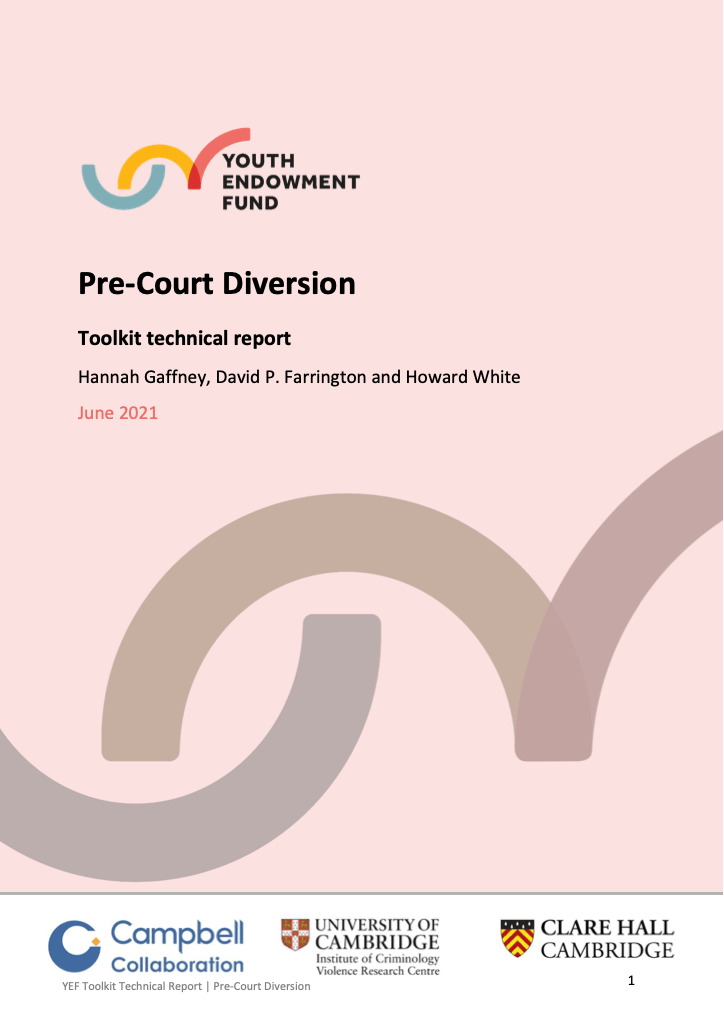
Diversion is an approach to preventing reoffending by finding alternatives to formal criminal justice proceedings. Diversion can occur at different points in the criminal justice system: at the point of arrest, before charges are made, or in court through alternative forms of sentencing.
This summary focuses on diversion that takes place before a formal charge and court proceedings. In England and Wales there are two types of pre-court diversion:
The diversion process may support or require the child to complete an intervention programme. This could involve counselling, mental health interventions, employment training or restorative justice.
There are several reasons why pre-court diversion could protect a child against future involvement in crime and violence.
On average, pre-court diversion is likely to have a moderate impact on violent crime.
Pre-court diversion leads to greater reductions in reoffending than processing through the courts. The research suggests that pre-court diversion reduces reoffending by 13%. Furthermore, if children are diverted but do commit another offence, this offence is likely to be less serious.
There is also evidence that pre-court diversion has a greater impact than diversion after a charge is made. This provides support for the argument that you can achieve greater impacts by limiting a child’s experience of the criminal justice system.
Current evidence suggests the impact of pre-court diversion has been greater with younger children (aged 12-14) than with older children (aged 15-17).
The research suggests that pre-court diversion reduces reoffending by 13%.
Our confidence in the estimate of the average impact on violent crime is high.
The estimate is based on a high-quality review of many studies. The available research has directly measured the impact on reoffending but has not separated out the impact on violent reoffending within this. We have not awarded the highest evidence quality rating because there is a lot of variation in the estimates provided by the underlying research. Some studies suggest that pre-court diversion can have a more positive impact while other studies suggest that the impact is smaller.
Most of the research comes from the USA and very few studies have been conducted in England and Wales. In April 2021 the YEF launched a funding round focused on diversion with the aim of improving the evidence base in England and Wales.
The research suggests that speed of referral is important and should happen soon after an arrest occurs. Some services aim to increase the speed of referral by making referral as simple and straightforward for the police as possible.
Even arrests or attending a police station for questioning could have labelling implications. Some services respond to this by avoiding arresting children involved in low-level offending. Instead, the children are taken to a safe place to discuss next steps and undertake an initial referral assessment.
Effective diversion requires the collaboration of several agencies. The pilot evaluation of the Youth Justice Liaison and Diversion (YJLD) scheme in England and Wales suggested that this could be challenging. Young people reported contact with a “panoply of professional agencies” and some reported feeling let down or disappointed with their experiences and showed some resentment towards intervention attempts. The staff involved in the scheme stated that communication and collaboration across different agencies was a barrier to successful and swift implementation.
One approach to improving multi-agency collaboration might be to locate YOT or YJLD staff in or close to the custody suite so that they can begin to work with children immediately. One study suggested that it may be preferable for staff to be near the custody suite, but not co-located, so they are seen as independent and separate to the police.
On average, the cost of pre-court diversion is likely to be low.
This estimate is based on an analysis of 300 UK diversion projects and an evaluation of the Liaison and Diversion Service. In many situations, pre-court diversion is likely to lead to significant cost savings as it prevents the expense of formal processing through the courts.